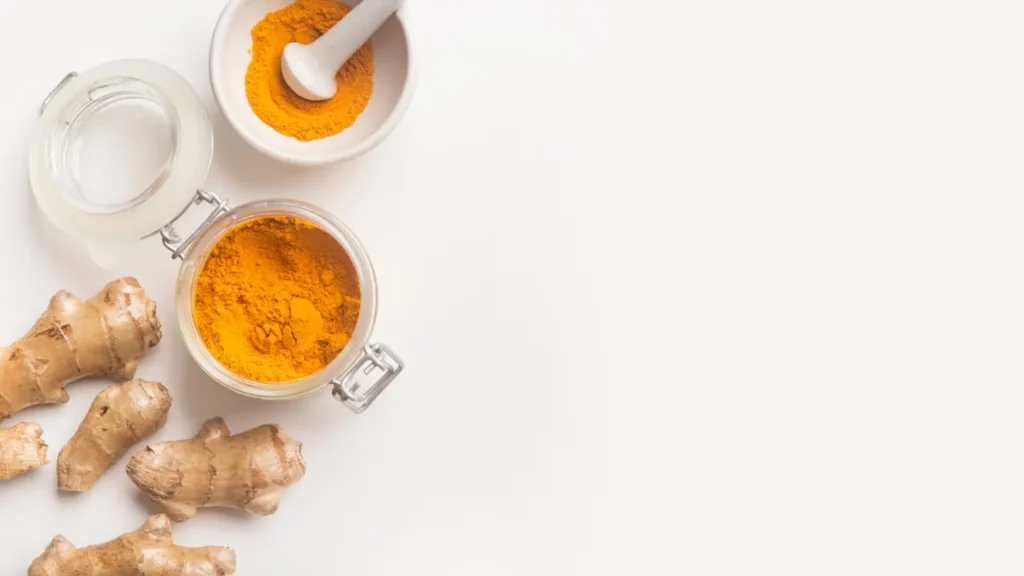Turmeric is a golden-hued spice appreciated in both culinary and medicinal contexts. It has been a staple in traditional medical systems such as Ayurveda and Traditional Chinese medicine for ages. Turmeric also has a place in traditional cooking and cuisine. Turmeric’s popularity in the health and wellness world is mostly due to its bioactive chemicals, known as curcuminoids. This page digs into turmeric’s multidimensional nature, including its chemical composition, health benefits, optimal dosage, adverse effects, potential substance interactions, and recommendations for its responsible usage.
You May Also Like:
CBD for Concentration: The Productivity Hack for Energy and Focus
Wasabi: Benefits, Dosage, Side Effects, Drug Interactions, And Other Important Information
Turmeric: Benefits, Dosage, Side Effects, Drug Interactions, and Other Important Information is an original (NootropicsPlanet) article.
The Nature of Turmeric
Turmeric (Curcuma longa) is a perennial herbaceous plant from the ginger family, Zingiberaceae. The plant’s rhizomes are ground into a fine powder to produce what is known as the turmeric spice. Turmeric contains numerous chemicals, however, the most notable of which are curcuminoids, which are known for their medicinal benefits. Curcumin, demethoxycurcumin, and bisdemethoxycurcumin are the primary curcuminoids. These chemicals provide turmeric its significant anti-inflammatory, antioxidant, and neuroprotective properties.
Turmeric’s brilliant yellow hue is due to the presence of curcumin. The spice’s complex chemical structure also includes volatile oils including turmerone, atlantone, and zingiberene, which add to its distinct aroma and have been explored for their health benefits.
Health Benefits of Turmeric
Turmeric’s health advantages are numerous and well-documented, ranging from anti-inflammatory and antioxidant properties to a potential role in neuroprotection and cognitive enhancement. Curcumin’s anti-inflammatory qualities are particularly significant, as they provide a natural way to reduce chronic inflammation, which is the fundamental cause of many chronic diseases. This action is mediated by the downregulation of several inflammatory cytokines and enzymes, such as TNF-α and COX-2.
Furthermore, curcumin has a strong antioxidant potential, allowing it to destroy free radicals while also boosting the body’s antioxidant enzymes. This dual action not only prevents cell damage but also promotes general health and longevity. Curcumin has shown promise in trials involving neuroprotection and cognitive enhancement. Its capacity to pass the blood-brain barrier permits its direct effect on the brain. It improves brain health and plasticity, which could benefit the prevention and treatment of neurodegenerative illnesses like Alzheimer’s. Furthermore, curcumin has been shown to promote neurogenesis, notably in the hippocampus, a brain region critical for learning and memory.

Chemistry of Turmeric
As mentioned, curcumin, the polyphenol that gives turmeric its distinctive yellow color, is crucial to its health benefits. Curcumin is structurally related to the curcuminoid family, which includes three primary compounds: curcumin (diferuloylmethane), demethoxycurcumin, and bisdemethoxycurcumin. These chemicals have powerful antioxidant and anti-inflammatory effects. Curcumin’s chemical structure enables it to neutralize free radicals via its phenolic hydroxyl groups, which can transfer hydrogen atoms to free radicals, stabilizing them and preventing additional cellular damage.
Moreover, curcumin interacts with a broad range of molecular targets, including enzymes, receptors, cytokines, cell cycle proteins, and transcription factors. However, curcumin is rapidly metabolized and excreted leaving little to be absorbed and utilized by the body. Thus, by improving the drug’s solubility, absorption, and retention in the body, its benefits can be better utilized. For instance, formulation technology advancements including liposomal curcumin, piperine, and nanoparticle encapsulation seek to circumvent these restrictions on absorption.
Physiological Mechanism of Action of Turmeric
Turmeric has a wide range of physiological impacts on many pathways related to inflammation, oxidation, and neurology. As mentioned, these actions are mostly due to curcumin. Curcumin’s ability to suppress the nuclear factor-kappa B (NF-κB) pathway is a crucial mechanism behind its anti-inflammatory effects. The transcription factor NF-κB is essential for the inflammatory response because it activates the genes that produce adhesion molecules, chemokines, and pro-inflammatory cytokines. Curcumin inhibits NF-κB activation, which lowers the production of key mediators of inflammation.
The capacity of curcumin to influence various signaling pathways is critical for cognition and neuroprotection. It has been demonstrated to improve hippocampal neurogenesis, or the development of new neurons, a region essential to memory and learning. For instance, Brain-derived neurotrophic factor (BDNF) which is a protein that promotes the development of new synapses and maintains the viability of existing neurons is upregulated by turmeric.
Furthermore, it has been discovered that curcumin lessens the development of amyloid plaques in animal models of Alzheimer’s disease. Alzheimer’s disease pathogenesis is typified by amyloid plaques, which are made up of misfolded amyloid-β proteins. Curcumin aids in the clearance of these plaques by strengthening the phagocytic action of macrophages against amyloid-β and preventing the aggregation of amyloid-β proteins.
Curcumin’s neuroprotective benefits are further enhanced by its antioxidant qualities. Curcumin shields neuronal cells from oxidative stress which is a major cause of dementia by scavenging free radicals and boosting the body’s natural antioxidant enzyme activity.


Optimal Dosage of Turmeric
It is difficult to determine the ideal dosage of turmeric for improving cognition and providing general health benefits, partly because different turmeric preparations include varying amounts of curcumin and because people’s bodies metabolize and absorb turmeric differently. Typically, 500–2,000 mg of curcumin per day, in divided doses, have been frequently utilized in research.
Curcumin’s limited bioavailability, however, has led to the creation of several formulations to improve its absorption. For example, piperine, which is present in black pepper, can be combined with curcumin, or curcumin can be packaged in lipid-based delivery systems like liposomes. Curcumin’s bioavailability can be greatly increased by these formulations, increasing the efficacy of smaller doses.
Side Effects of Turmeric
When taken in proportions commonly found in food, most people consider turmeric to be safe. However, curcumin overuse or long-term dosage may result in gastrointestinal problems such as indigestion, diarrhea, and nausea.
Potential Substance Interactions of Turmeric
Numerous drugs and supplements may interact with turmeric, reducing their effectiveness or raising the possibility of negative side effects. For instance, turmeric may interfere with the way medications are processed by the cytochrome P450 enzymes in the liver, which could change the amount of medication in the body. Turmeric has also been shown to interact with anticoagulants and antiplatelet drugs, which can make bleeding more likely. Thus, before beginning a turmeric supplement, anyone using such medications should speak with a healthcare professional.


Best Responsible Use of Turmeric
When utilizing turmeric for its cognitive and health benefits, there are a few things to keep in mind. First and foremost, it’s critical to select a premium turmeric or curcumin product with established bioavailability. Secondly, safety depends on following prescribed dosages and keeping an eye out for any negative reactions or drug combinations. Lastly, turmeric should be combined with a holistic approach that includes a healthy diet, consistent exercise, and enough sleep.
Turmeric:
Conclusion
Turmeric is often used in cooking because of its distinct aroma. Another notable quality of turmeric is its brilliant yellow hue which comes from the presence of curcumin in turmeric. From the article, we know that turmeric comes from the ginger family and it contains many medicinal components such as curcumin, demethoxycurcumin, and bisdemethoxycurcumin. These are all primary curcuminoids that bring turmeric strong anti-inflammatory, antioxidant, and neuroprotective properties. These properties can effectively reduce oxidative stress buildup in the brain and may decrease the onset of neurodegenerative diseases such as dementia.
However, like any supplement, you would need to consult your doctor before taking and you must follow the proper dosage guidance. Even though, turmeric is fast to be metabolized in the body and the absorption rate is slow, you still need to gradually adjust the dosage by starting with a low dose.


References:
- 10 Health Benefits of Turmeric and Curcumin. Retrieved from:https://www.healthline.com/nutrition/top-10-evidence-based-health-benefits-of-turmeric
- Health Benefits of Turmeric. Retrieved from: https://www.webmd.com/diet/ss/slideshow-turmeric
- What are the Benefits of Turmeric? Retrieved from: https://www.medicalnewstoday.com/articles/318405
- Curcumin: A Review of Its Effects on Human Health. Retrieved from: https://www.ncbi.nlm.nih.gov/pmc/articles/PMC5664031/
Important Note: The information contained in this article is for general informational purposes only, and should not be construed as health or medical advice, nor is it intended to diagnose, prevent, treat, or cure any disease or health condition. Before embarking on any diet, fitness regimen, or program of nutritional supplementation, it is advisable to consult your healthcare professional in order to determine its safety and probable efficacy in terms of your individual state of health.
Regarding Nutritional Supplements Or Other Non-Prescription Health Products: If any nutritional supplements or other non-prescription health products are mentioned in the foregoing article, any claims or statements made about them have not been evaluated by the U.S. Food and Drug Administration, and such nutritional supplements or other health products are not intended to diagnose, treat, cure, or prevent any disease.
